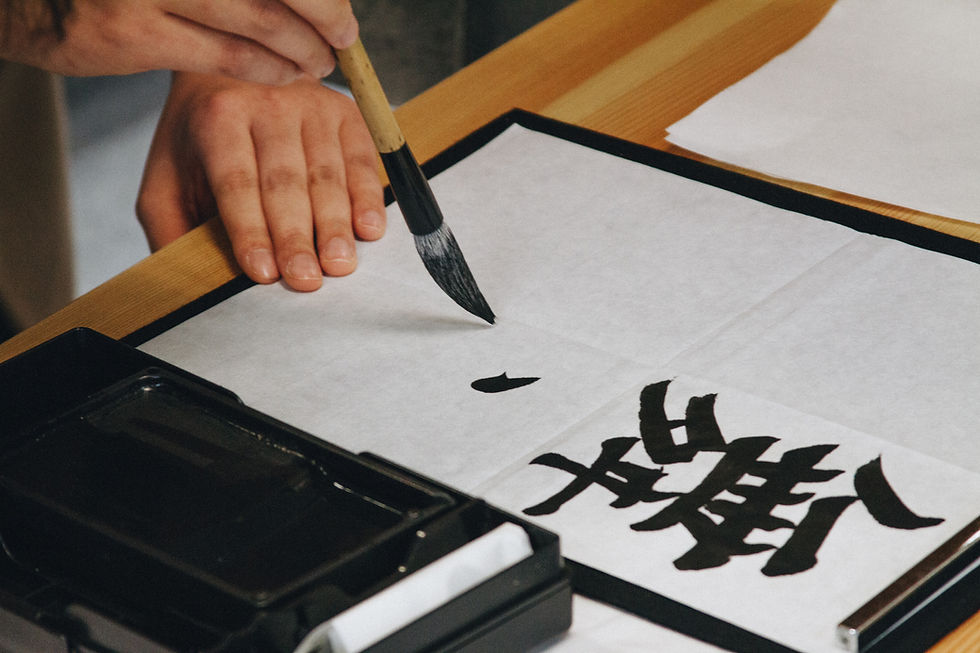
Calligraphy, the beautiful and intricate art of expressive handwriting, has been around for centuries, evolving from simple symbols etched on stone to the graceful and elaborate lettering we see today. The beauty of calligraphy lies in its ability to transform everyday text into a work of art, adding a touch of elegance and creativity to even the most mundane of documents. In this blog post, we'll delve into the mesmerizing world of calligraphy, exploring both modern and traditional styles. We'll also discuss the tools and techniques that make this art form so captivating, and provide tips on how you can learn calligraphy yourself. So, grab your favorite pen, and let's get started!
Traditional Styles
Copperplate calligraphy, also known as English round hand, is one of the most well-known and widely practiced calligraphy styles. Developed in the 16th century, it's characterized by its elegant, flowing script and hairline-thin strokes. Copperplate is often used for formal invitations, certificates, and other important documents, as its elegant appearance conveys a sense of sophistication.
Gothic calligraphy, also known as Blackletter, originated in medieval Europe and is instantly recognizable by its dark, angular strokes and ornate lettering. Although it may appear complex at first glance, Gothic calligraphy is actually quite structured, making it a great style to learn for beginners. It's often used for dramatic, eye-catching designs, such as tattoos, logos, and posters.
Italic The Italic calligraphy style, as the name suggests, is an italicized script with a slanted orientation. It was developed during the Renaissance and is renowned for its elegant and flowing appearance. Italic calligraphy is often used for invitations, personal correspondence, and other documents where a sense of refinement is desired. This style is considered beginner-friendly due to its relatively simple structure.
East Asian Calligraphy East Asian calligraphy is an umbrella term for the various calligraphy styles originating from China, Japan, and Korea. These styles are often characterized by their use of brushes and ink, rather than pens, and their emphasis on balance and harmony within each character. Some popular East Asian calligraphy styles include:
Chinese: Regular script, semi-cursive script, and cursive script
Japanese: Kaisho, Gyosho, and Sosho
Korean: Hangul and Hanja
Modern Styles
Brush Lettering Brush lettering is a versatile and popular modern calligraphy style that has gained traction in recent years. It's characterized by its use of brush pens, which allow for a wide range of stroke thicknesses, giving the letters a dynamic and organic appearance. Brush lettering is often seen on greeting cards, signage, and other casual applications, as its laid-back style is both eye-catching and approachable.
Faux Calligraphy Faux calligraphy is a technique that mimics the appearance of traditional calligraphy styles without the need for specialized tools or extensive training. By simply adding thick and thin strokes to regular handwriting, faux calligraphy creates the illusion of more complex scripts. This style is perfect for those who want to dabble in calligraphy without the commitment of purchasing tools or mastering a new skill.
Watercolor Calligraphy Watercolor calligraphy combines the beauty of calligraphy with the vibrant colors and fluidity of watercolor painting. This style is achieved by using watercolor paints or inks to create stunning and unique lettering designs. Watercolor calligraphy is perfect for adding a whimsical touch to wedding invitations, greeting cards, or personal artwork, and its dreamy, ethereal quality is sure to impress.
Hand Lettering Hand lettering is a more free-form style of calligraphy that emphasizes personal expression and creativity. It involves designing custom fonts and lettering styles, often combining elements from multiple calligraphy and typography styles. Hand lettering is popular in branding, logo design, and inspirational quotes, as it allows for a distinctive and memorable appearance.
Tools and Techniques
Nibs and Pens Calligraphy nibs come in various shapes and sizes, each suited for a specific style or purpose. Some popular nib types include pointed nibs (used for Copperplate and modern calligraphy), broad-edged nibs (used for Gothic and Italic), and brush nibs (used for brush lettering). Calligraphy pens, such as dip pens, fountain pens, and brush pens, hold the nibs and provide a comfortable grip for the artist.
Inks and Paper High-quality inks and paper are essential for creating beautiful calligraphy. Calligraphy inks come in various colors and types, such as pigmented, water-based, or even metallic. Acid-free, smooth, and heavyweight paper is ideal for calligraphy, as it prevents ink from bleeding and ensures crisp, clean lines.
Guidelines and Grids Guidelines and grids help calligraphers maintain consistent lettering, spacing, and angles. Beginners should start by using practice sheets with pre-drawn guidelines, while more advanced calligraphers can create their own custom grids using a ruler and pencil.
Learning Calligraphy
Online Tutorials and Courses There are numerous online tutorials and courses available for aspiring calligraphers, ranging from free YouTube videos to paid, structured courses. Start by finding a style that resonates with you and practice the basic strokes and letterforms.
Books and Workbooks Books and workbooks on calligraphy offer in-depth explanations and step-by-step guides on various styles and techniques. They often include practice sheets and projects to help you develop your skills and confidence.
Local Workshops and Classes Many cities and towns offer calligraphy workshops and classes, which provide hands-on instruction and personalized feedback from experienced calligraphers. These classes are also a great way to meet fellow calligraphy enthusiasts and build a supportive community.
I must admit that I have not experimented with calligraphy and this post has renewed my interest in experimentation. The beauty of calligraphy lies in its ability to elevate ordinary text into an extraordinary work of art. By exploring both modern and traditional styles, experimenting with different tools and techniques, and dedicating time to practice and learning, you too can discover the captivating world of calligraphy and add a touch of elegance to your everyday life.

Comments